
Concept explainers
(a)
Interpretation: The name of the following compound needs to be determined.

Concept Introduction : The name of an organic compound has three parts, prefix, parent chain and suffix. The format of naming is prefix+parent chain+suffix. The parent chain is the longest chain of carbon atoms in the compound. Suffix denote the name of
(a)
Answer to Problem 15E
The name of the compound is 1,3-dichlorobutane.
Explanation of Solution
The compound is as follows:

First identify the parent chain of the compound. The parent chain consists of four carbon atoms. So, the name of parent chain is ‘but’. The compound consist of only single bonds so, name of suffix ‘ane’ should be used. Two chlorine atoms present in C1 and C3. So, the name of the compound is 1,3-dichlorobutane.
(b)
Interpretation: The name of the following compound needs to be determined.
Concept Introduction : The name of an organic compound has three parts, prefix, parent chain and suffix. The format of naming is prefix+parent chain+suffix. The parent chain is the longest chain of carbon atoms in the compound. Suffix denote the name of functional group and prefix denote the substituent present in the compound.
(b)
Answer to Problem 15E
The name of the compound is 1,1,1-trichlorobutane
Explanation of Solution
The compound is
(c)
Interpretation: The name of the following compound needs to be determined.
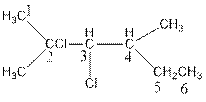
Concept Introduction : The name of an organic compound has three parts, prefix, parent chain and suffix. The format of naming is prefix+parent chain+suffix. The parent chain is the longest chain of carbon atoms in the compound. Suffix denote the name of functional group and prefix denote the substituent present in the compound.
(c)
Answer to Problem 15E
The name of the compound is 2, 3-dichloro-2-4-dimethyhexane
Explanation of Solution
The compound is as follows:
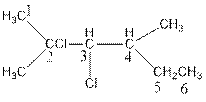
The parent chain consists of six carbon atoms. So, the name of parent chain is ‘hex’. Only single bonds present in the compound. So, suffix would be ‘ane’. Two chlorine atoms present in C2 and C3 and two methyl atoms present in C2 and C4. So, the name of the compound is 2,3-dichloro-2-4-dimethyhexane.
(d)
Interpretation: The name of the following compound needs to be determined.
Concept Introduction: The name of an organic compound has three parts, prefix, parent chain and suffix. The format of naming is prefix+parent chain+suffix. The parent chain is the longest chain of carbon atoms in the compound. Suffix denote the name of functional group and prefix denote the substituent present in the compound.
(d)
Answer to Problem 15E
The name of the following compound is 1,2-difluoroethane
Explanation of Solution

In
(e)
Interpretation: The name of the following compound needs to be determined.

Concept Introduction: The name of an organic compound has three parts, prefix, parent chain and suffix. The format of naming is prefix+parent chain+suffix. The parent chain is the longest chain of carbon atoms in the compound. Suffixdenote the name of functional group and prefix denote the substituent present in the compound.
(e)
Answer to Problem 15E
The name of the compound is 3-iodobut-1-ene.
Explanation of Solution
The compound is,

The parent carbon chain consists of four carbon atoms. So, the name of the parent chain is ‘but’, double bond present. So, name of suffix is ‘ene’. One iodine atom present at C3. So, the name of the compound is 3-iodobut-1-ene.
(f)
Interpretation: The name of the following compound needs to be determined.
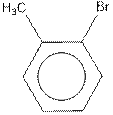
Concept Introduction: In naming of benzene compound prefix is used to denote the substituents present in the compound before the word ’benzene’. If more than one substituent is present, then the substituents are arranged in alphabetical order.
(f)
Answer to Problem 15E
The name of the compound is 1-bromo-2-methylbenzene.
Explanation of Solution
The name of the compound is as follows:
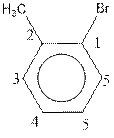
The compound is a benzene compound. One bromine atom is present at C1 and one methyl group is at C2. So, the name of the compound is 1-bromo-2-methylbenzene.
(g)
Interpretation: The name of the following compound needs to be determined.
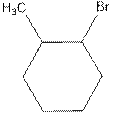
Concept Introduction: In naming of cyclic compound, naming is done in the format,
Prefix+Cyclo+parent chain+suffix
Prefix denotes the name of the substituent. If more than one substituent is present then they should be arranged in alphabetical order.
(g)
Answer to Problem 15E
The name of the compound is 1-bromo-2-methylcyclohexane.
Explanation of Solution
The compound is as follows:
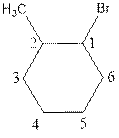
The above compound is cyclic compound. One bromine atom is present at C1 and one methyl atom is present at C2. And the parent chain consists of six carbon atoms. So, the name of the compound is 1-bromo-2-methylcyclohexane.
(h)
Interpretation: The name of the following compound needs to be determined.
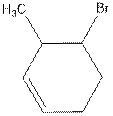
Concept Introduction: In naming of cyclic compound, naming is done in the format,
Prefix+Cyclo+parent chain+suffix
Prefix denotes the name of the substituent. If more than one substituent is present, they should be arranged in alphabetical order.
(h)
Answer to Problem 15E
The name of the compound is 1-bromo-2-methylcyclohex-3-ene.
Explanation of Solution
The compound is as follows:
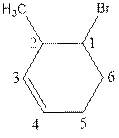
The above compound is cyclic compound. One bromine atom is present at C1 and one methyl atom is present at C2. The parent chain consists of six carbon atoms and one double bond at C3. So, the name of the compound is 1-bromo-2-methylcyclohex-3-ene.
Want to see more full solutions like this?
Chapter 21 Solutions
EBK WEBASSIGN FOR ZUMDAHL'S CHEMICAL PR
- Synthesize 2-Ethyl-3-methyloxirane from dimethyl(propyl)sulfonium iodide using the necessary organic or inorganic reagents. Draw the structures of the compounds.arrow_forwardSynthesize 2-Hydroxy-2-phenylacetonitrile from phenylmethanol using the necessary organic or inorganic reagents. Draw the structures of the compounds.arrow_forwardSynthesize N-Methylcyclohexylamine from cyclohexanol using the necessary organic or inorganic reagents. Draw the structures of the compounds.arrow_forward
- Synthesize N-Methylcyclohexylamine from cyclohexanol using the necessary organic or inorganic reagents. Draw the structures of the compounds.arrow_forwardIf possible, please provide the formula of the compound 3,3-dimethylbut-2-enal.arrow_forwardSynthesize 1,4-dibromobenzene from acetanilide (N-phenylacetamide) using the necessary organic or inorganic reagents. Draw the structures of the compounds.arrow_forward
- Indicate the products obtained by mixing (3-oxo-3-phenylpropyl)triphenylphosphonium bromide with sodium hydride.arrow_forwardWe mix N-ethyl-2-hexanamine with excess methyl iodide and followed by heating with aqueous Ag2O. Indicate the major products obtained.arrow_forwardIndicate the products obtained by mixing acetophenone with iodine and NaOH.arrow_forward
- Indicate the products obtained by mixing 2-Propanone and ethyllithium and performing a subsequent acid hydrolysis.arrow_forwardIndicate the products obtained if (E)-2-butenal and 3-oxo-butanenitrile are mixed with sodium ethoxide in ethanol.arrow_forwardQuestion 3 (4 points), Draw a full arrow-pushing mechanism for the following reaction Please draw all structures clearly. Note that this intramolecular cyclization is analogous to the mechanism for halohydrin formation. COH Br + HBr Brarrow_forward
 Introductory Chemistry: A FoundationChemistryISBN:9781337399425Author:Steven S. Zumdahl, Donald J. DeCostePublisher:Cengage Learning
Introductory Chemistry: A FoundationChemistryISBN:9781337399425Author:Steven S. Zumdahl, Donald J. DeCostePublisher:Cengage Learning Chemistry for Engineering StudentsChemistryISBN:9781337398909Author:Lawrence S. Brown, Tom HolmePublisher:Cengage Learning
Chemistry for Engineering StudentsChemistryISBN:9781337398909Author:Lawrence S. Brown, Tom HolmePublisher:Cengage Learning World of Chemistry, 3rd editionChemistryISBN:9781133109655Author:Steven S. Zumdahl, Susan L. Zumdahl, Donald J. DeCostePublisher:Brooks / Cole / Cengage Learning
World of Chemistry, 3rd editionChemistryISBN:9781133109655Author:Steven S. Zumdahl, Susan L. Zumdahl, Donald J. DeCostePublisher:Brooks / Cole / Cengage Learning ChemistryChemistryISBN:9781305957404Author:Steven S. Zumdahl, Susan A. Zumdahl, Donald J. DeCostePublisher:Cengage Learning
ChemistryChemistryISBN:9781305957404Author:Steven S. Zumdahl, Susan A. Zumdahl, Donald J. DeCostePublisher:Cengage Learning
 Chemistry: An Atoms First ApproachChemistryISBN:9781305079243Author:Steven S. Zumdahl, Susan A. ZumdahlPublisher:Cengage Learning
Chemistry: An Atoms First ApproachChemistryISBN:9781305079243Author:Steven S. Zumdahl, Susan A. ZumdahlPublisher:Cengage Learning





